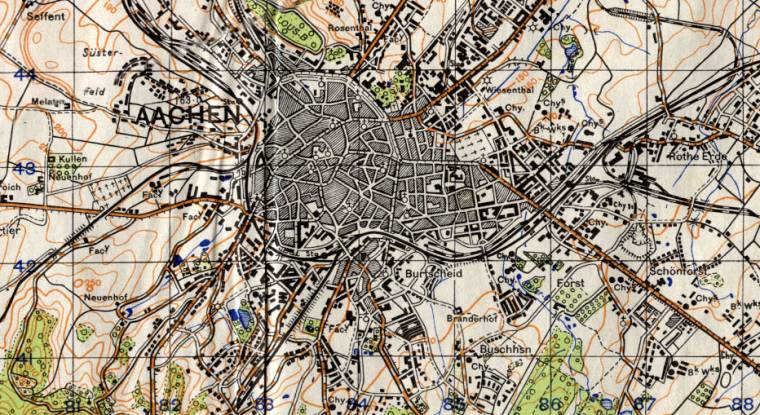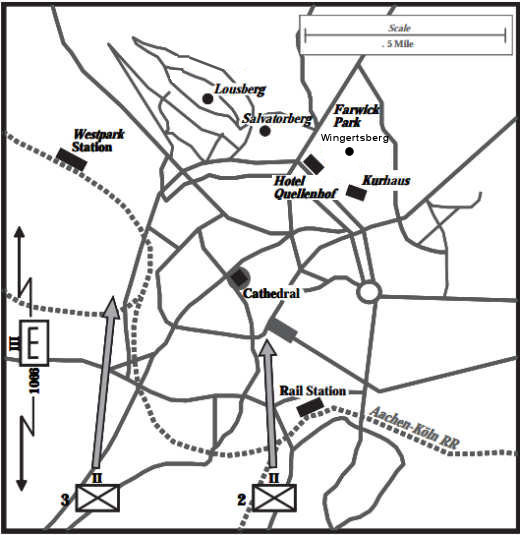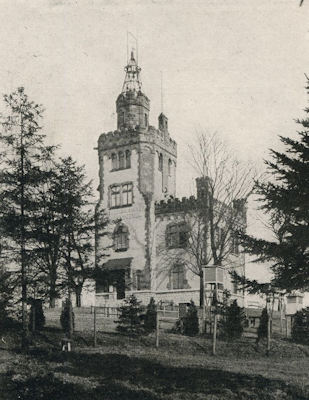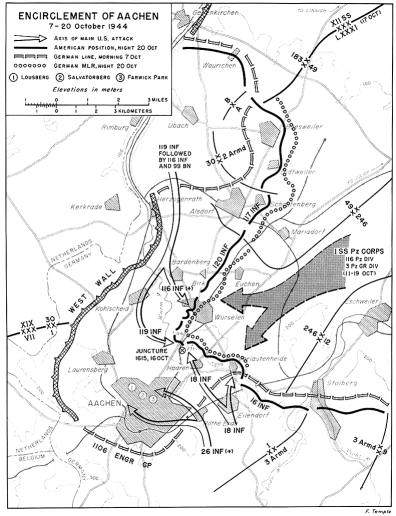1ST INFANTRY DIVISION
FOR THE PERIOD 1 OCTOBER - 31 OCTOBER 1944


HEADQUARTERS 26TH INFANTRY
APO .NO. 1, U.S. ARMY
1 November 1944
9 October
The 18th Infantry sector was the scene of a lively firefight as the Germans launched another of their attacks, which was beaten off after some effort.
"L" Company was driving out the enemy groups in houses on the right side of a street and about ready to start clearing out the groups on the left side. Company "F" was still moving towards the railroad, with the leading platoon being placed under heavy 77mm fire. While Company "F" drove west, Company "G" worked north, both companies clearing out the enemy pocket below the tracks. Mines and booby traps in the buildings made for redoubled caution. House to house progress was slow, and it was not until 2000 hours that most of them had been cleared out. Groups from two to ten Germans were defending each house. M-10s backing up the attack and battering the houses helped the infantry. White phosphorus rifle grenades were found better than thermite in this type of fighting.
The plan called for the 2nd Battalion working in the sector above the tracks as soon as both 2nd Bn. Companies and ”L" Company had cleared the areas below these.
10 October
General Huebner called Colonel Seitz and detailed the procedure Lt. Boehme and Lt. Lafley were to follow in delivering the ultimatum to the German garrison. Every precaution had been made to ensure that the terms of the ultimatum would get widest circulation: two PA systems broadcast the terms to the German front line troops; the Luxembourg radio was used to communicate terms to the people of Aachen; 210 rounds of propaganda shells were fired into the city, giving the details of the ultimatum; the terms of the ultimatum gave the town garrison 24 hours to surrender, and failing acceptance of that, permitted within that period the evacuation of civilians.
Lt Lafley contacted the Germans at the underpass near the railroad tracks, and after stating his mission, was taken blindfolded to an enemy CP where he spoke to the battalion adjutant of the German troops and delivered the terms. Indications then were that the ultimatum would be refused, and that the offer to clear the civilians would also be turned down.
Preparations were then made by the 2nd and 3rd Battalions to begin the infantry assault which was to follow in the wake of a tremendous air and artillery bombardment upon the town, scheduled the early hours of the morning of October 11th. General Huebner would give the signal to attack.
11 October
White flags appeared in all sections of Aachen about 0900 hours, but detachments of German soldiers observed from OPs forced the civilians to take down these symbols of surrender. Fighter planes dropped leaflets over the lines in the early morning hours, and about 1000 hours a group of about 20 Germans came through the 3rd Battalion outpost lines surrendering to the first American soldiers they met. These claimed that the majority of the soldiers in their unit asked to surrender, but were driven back by German officers armed with rifles and who shot anyone attempting to cross the tracks.
Artillery fire on targets north of the RR tracks hit a gas and ammunition dump, judging by the smoke and explosions, and Captain Chaplin, the "L" Company commander nearest that point adjusted fire until the artillery was registering directly on the target, a building at 85004225. Air activity from noon on, at which time the ultimatum expired, was intense: Flights of planes constantly over the area. Strafing was accomplished by the flights as soon as the bombing was completed. Factories north of Burtscheid (847422) (848427) (852429) were reported burning. In general the bombing was concentrated in those areas south of and to the north of Aachen. Artillery barrages were laid down on the edges of town nearest the two battalion positions and to the center of town.
Fires from artillery, bombing and strafing created dust, smoke and haze that made accurate observation of results rather difficult.
Late in the afternoon, when the artillery bombardment had eased, the two battalions sent patrols into the city, these reporting that enemy defenses had not been too greatly impaired by the bombing and artillery fire. The enemy launched a particularly heavy attack upon the 18th Infantry north of Aachen, and the 3rd Battalion was cautioned not to push its patrolling too vigorously since the battalion might be needed in helping beat back the large-scale enemy attack in the 18th Infantry sector. Both the 1st and 3rd Battalions sent liaison officers to that CT in case of possible employment there. When word came at 2100 hours that the enemy attacks had eased off, the 3rd Battalion sent other patrols into the city, these returning with the report that enemy patrols were active. A crucifix cross in a prominent spot in Aachen was discovered being used as an OP: another indication of the enemy determination to use any means to conduct the fight to defend the city.
Enemy planes dropped incendiaries on railroad tracks at 860427 and high explosive bombs at 868423. Little damage was done, and no casualties resulted to our units.

12 October
The 3rd Battalion was given three objectives: to clear the factory district down to the city limits, next to clear the section called Rosenthal (Observatory Hill), and finally to secure the high ground of Lousberg. Once an objective had been secured, only upon Division authority was the next step to be taken by the battalion. To protect the 3rd Battalion rear against any enemy thrusts from Haaren, a company from the 2nd Bn. was to move east of the Brand Road.
The 2nd Battalion had its assignment to push against the section of the city above the railroad tracks and clear the area up to the cemetery.
First to lead off was the 3rd Battalion. By 1100 hours "K" Company had moved into the first factory and was engaged in a firefight with the enemy groups defending the building.
Companies "I" and "M" were shifted to the right of "K" Company and from then on progress was slow but steady. By 1345 hours "I" and "K" Companies had joined, and mopped up the buildings on each side of the street. 50 prisoners were sent back. "I" Company then turned north at 859448 and worked along its sector of buildings. Major Clisson received the 3rd Battalion report at 1450 hours that the battalion was on its first objective, and the factory area had been practically cleared. The fighting had absorbed all the companies in the battalion, with a force approximating one platoon at times representing the battalion reserve. Company "L" was relieved by "C" Company so that it could rejoin the 3rd Battalion, which was ordered to hold its positions for the night.
13 October
The 2nd Battalion then started its assault at 0830 hours, with "E" Company, followed by "F" Company crossing the tracks. Tanks with the 2nd Battalion could not cross the steep sides at that point and crossed further down, rejoining the battalion.
The direction of the thrust was towards the southern edge of the cemetery, with "E" Company reaching the halfway point by noon, and Company "F" clearing the buildings to the right of the tracks. "G" Company, keeping in contact with "C" Company, held the section along the tracks.
By 1000 hours the 3rd Battalion had pushed west of the factory area, against an apartment section of the city. "K" Company at 847437 was meeting anti-tank fire, but still advancing from house to house. Part of "E" Company by 1330 hours was west of Rothe Erde. Gains were measured in rooms and houses taken. At 1626 hours, the artillery-infantry-air team turned in an excellent performance. An enemy point had been pinpointed for attack. The infantry called the coordinates - 834428 - the artillery laid on the red smoke while the flight of planes circled in the air, and then the planes hit the target precisely. The heavy enemy artillery firing that had been observed coming from that point stopped. Other targets were indicated on Lousberg Hill, and dive-bombed.
It was 1700 hours and the 3rd Battalion was still having heavy going of it: "I" Company working north towards Observatory Hill, and Companies "K" and "L" mopping up at the base of the hill. Adding to the difficulties of fighting against well-trained troops of excellent morale was the clever use of the city sewer system by the Germans. A group of the enemy would work along the passageways in the sewer and then appear in areas that were thought cleared. Each manhole had to be located, grenades thrown and the sewers thoroughly blocked and covered. At 1900 hours, the order was given to the 3rd Battalion to button up at the base of Observatory Hill.
Some of the sturdily constructed apartment houses had successfully withstood the fire from tanks and task destroyers. On the basis on this, a request was made for an SP 155mm rifle, and one of these powerful weapons given to the 3rd Battalion by the Division Artillery unit.

American troops attacking Aachen, Germany, in October 1944 faced determined German SS defenders
who had fortified the historic city.
The self-propelled gun is an M-12 155mm Gun Motor Carriage.
14 October
About midnight, enemy patrols attempted to penetrate "F" Company positions, but were driven back. "C” Company closed in along the railroad tracks and maintained physical contact with "G" Company.
In the early morning fighting, "L" Company cleared resistance between it and "F" Company, patrols of both companies meeting at a point near the cemetery. The first test with the SP 155mm rifle proved the weapon most successful - a building that had defied the tank and tank destroyer gunfire efforts was levelled by one shot from the big rifle. When enemy resistance proved too strong at the road junction near the church in the vicinity of Observatory Hill, Companies "I" and "K" attacked jointly and overran the enemy. Then "I" Company proceeded to the top of Observatory Hill, while "K" Company wore down the resistance of the enemy group to the left of that height. In the area north of the cemetery, "L" Company fought against determined enemy units that had to be blasted out from buildings before they abandoned each strongpoint.
While the companies remained in position for the night, Colonel Seitz made arrangements to obtain an SP 155 gun for the 2nd Battalion, and to switch "F" Company over into "L" Company's area near the cemetery in order to release "L" Company for the push on Observatory Hill, thinly held by one company.
There were additional restrictions on the use of ammunition; shortages in 155 rifle and 81mm mortar ammunition, made use of this type of ammunition a matter for employment only in critical situations.
15 October
About midnight, Company "F" patrols established definite contact with a patrol of Company "L". "F" Company was being held up by resistance from a two-story enemy pillbox. If attempts to reduce it with the means at hand failed, then the SP 155 rifle would be used in the morning. There was no need for this since threat of using flamethrowers frightened the enemy into surrendering. "C" Company pushed west during the night and joined forces with Company "G" in the vicinity of Branderhof; a composite group of AT platoon, I & R platoon and A & P detail moved to Neuenhof and maintained contact with Company "C".
Morning found the 3rd Battalion using this plan: "I" Company was to hold on Observatory Hill; "K" Company was to clear out the section at the base of the Hill; "L" Company was to move out and work towards "I" Company. 4.2 mortars were summoned up to cover the companies in their forward movement.
Enemy planes came oyer early and dropped supplies to enemy forces Northwest of Aachen. These missed being intercepted by our own air force by a matter of minutes: air support was available all day and on call for targets. One mission called for bombing a former hospital: though the hospital signs had been left prominently displayed, the Germans had cleared the hospital of patients and had used the building for a gasoline and ammunition dump. After the planes had been finished, the artillery than went to work on the target. Another air mission called by the 3rd Battalion on 838440, a point from which heavy mortar fire was being placed on "I" and "L” Companies, was executed perfectly. The enemy fire silenced, "L" Company moved forward on its mission to flank the enemy defenses and join "I" Company on the hill. "K" Company had run into particularly heavy fighting in front of the hotel and called for the SP 155 to help reduce the hotel.
It was to prove a busy morning for the 18th lnfantry as well. The enemy launched another counterattack in a desperate attempt to keep the escape route and remaining supply line open. For the third time in this Aachen operation, the 1st Battalion was alerted and moved out to Eilendorf, ready to be used to back up the 18th Infantry on Division orders.
General Huebner called Colonel Seitz on this, also detailing the Division plan to call up a battalion of tanks and a battalion of infantry and place these additional forces at the road junctions and roads leading into Aachen from the northwest.
Late afternoon, the German garrison launched its heaviest attack against the 3rd Battalion positions. "I" Company and "L" Company, the two organizations nearest Observatory Hill, the height the enemy desired, bore the brunt of the fighting. Despite the heavy mortar and machine-gun fire, the enemy leapt advancing until "F Company found itself involved in close fighting and hand-to-hand fighting. Preliminary reports placed the direction of the attack from the NW, S, and SW of the hill, and the enemy forced at one battalion backed by at least six tanks. Enemy mortars kept a constant barrage on the company positions on the hill until the enemy had closed within small-arms range.
Then the enemy tanks were employed to furnish fire on those 3rd Battalion points giving the enemy infantry most trouble. It was touch and go for more than an hour. The enemy attack then veered to the west and ran into "L" Company, piling up attack upon attack on that company. By 1700 hours the enemy attacks eased off, and the 3rd Battalion could report that the companies would not only hold their own, but resume their advance upon Observatory Hill.
One German tank had been knocked out in the fighting.
All through the afternoon, the 2nd Battalion systematically and efficiently mopped up as it advanced in its sector. By 1700 hours it had reached its objective and established defenses for the night. Two hours later the 3rd Battalion had "I", "K", and "L” Companies in physical contact, with "L" some 100 yards in front of the hill, and "I" and "K" on the height.
While both battalions were so engaged, "C" Company pushed against the enemy pockets between Branderhof and the outskirts of Burtscheid.
Perhaps one explanation for the stiffening of resistance might be found in the Intelligence Report that the German commander who had refused the ultimatum had been replaced by a Colonel Wilck, who had direct orders from Hitler to hold on and fight to the last man. But the noose was drawing tighter.
16 October
All was quiet during the night, but in the early morning heavy attacks against the 16th and 18th Infantry positions above Aachen kept the 2nd and 3rd Battalions in place until further orders. 3rd Battalion was alerted against expected attack, and about 0900 hours "L" Company, which was occupying ground on left side of the tower on Observatory Hill, was strongly engaged with the enemy. The AT Platoon was committed in the company fight to hold its ground. "I" and "K" Companies fought off probing attacks at the same time. The fight in the "E" Company area lasted most of the morning; the company held firm and as soon as the enemy showed signs of withdrawing, platoons followed these and overran a German 150mm mortar that had been firing on the 3rd Battalion and on 18th Infantry positions.
The 2nd Battalion pushed as soon as the pressure eased in the 18th Infantry sector, and steady progress was made towards the 3rd Battalion positions. An underground hospital was captured, and the wounded personnel moved out. Civilians were also getting in the path of the 2nd Battalion; arrangements were made to clear these out as quickly as possible.

Fight for the city center.
17 October
At 0530 hours enemy planes dropped heavy bombs and antipersonnel bombs in Aachen, none of these landing in the battalion areas. Until 0630 hours, when the first friendly planes came over, three enemy planes hovered over the city.
The 3rd Battalion, having secured most of Observatory Hill, now pushed towards Salvator and Lousberg Hills. 4.2 mortars were proving invaluable in laying down harassing fire for the advancing troops. The 2nd Battalion also leapt pace in its progress with "C" Company, though heavily engaged, keeping contact with "G" Company. By noon, "K" Company had reached the junction, at Julicher and Monheims Allees, where an enemy tank laid steady fire upon the platoons as they tried to move up Monheimsallee. "I" Company spent the morning and afternoon cleaning out the whole of the northern area near Salvator Hill.
By 1700 hours both battalions were buttoned up. The plan called for heavy artillery barrages between 1900 hours 17 October - 0400 hours 18 October 1944, and the 3rd Battalion resuming the attack at 0630 hours, while the 2nd Battalion jumped off an hour later.
18 October
The Palace Hotel and the Kurhaus, two remaining strongpoints on Observatory Hill, were reduced by late morning, with the 155 rifle being effectively employed by the 3rd Battalion.
Then the movement on Lousberg Hill was resumed. The 2nd Battalion made its steady way across the city.
19 October
At 0900 hours "L" Company reported it was at the east end of Lousberg Hill; "I" Company was on the southern end of Salvator, with "K" Company clearing out the enemy strongpoints directly on the hill. By late afternoon, the southern end of Lousberg had been cleared, and the attack on the higher slopes was halted for the night. The 2nd Battalion had pushed clear through Aachen to sections of Lousberg, and it too buttoned up for the night. Though the trap was practically sprung, German elements still fought efficiently, and had to be driven out of each position.
20 October
Against heavy resistance, the 3rd Battalion made slow, but steady gains in the Lousberg area. Another captured hospital yielded its share of wounded soldiers and civilians which were evacuated by the Military Government Officer. Over 400 prisoners were captured by noon. The 2nd Battalion spent most of the day reducing the strongpoints into which the Technical School had been converted by the enemy. The German garrison being squeezed into a restricted area, and the end was in sight.
21 October
Both battalions made additional gains in the Lousberg sector. At about 1100 hours, the first sign came that the German commander of the Aachen forces was willing to accept unconditional surrender. Lt. Reynolds, Lt Boehme and a German staff officer contacted Colonel Wilck, and the German commander, in a formal ceremony, handed over his garrison to Brig. Gen. George A Taylor, Asst. Cmdr., 1st Division. Some 1600 soldiers, the remnants of a garrison, were marched back to the rear to join approximately 1800 other Aachen garrison captives now in PW enclosures. For purposes of record, a digest of the last speech of the German Colonel is included in this report:
'Dear German Soldiers'
I am speaking to you on a most painful occasion. I was forced to surrender because we had run out of ammunition, food and water, and therefore saw further fighting was useless. I was acting against orders, for I was supposed to fight to the last man.
At this time I have to remind you that you are German soldiers, please, and to behave as such. I also wish you the best of health, and a speedy return to the Fatherland after the cessation of hostilities in order to help rebuild Germany. I was refused by the American authorities to give a "Sieg Heil" and "Heil Hitler", but we can all still do that in our minds."
Colonel, Comdg,
Aachen Forces.
However, the day to day record was plain. Though the German garrison had fought courageously and skillfully, it had been beaten by a combined American force of half its size.
Little remained then but clearing the battered city of hostile elements which had not heard of the German commander s surrender. Towards late afternoon, "C" Company was released to return to the 1st Battalion, and arrangements made to return the 3rd Battalion to the Auf Der Hüls area, and the 2nd Battalion to the barracks in the vicinity of Brand. Tanks and tank destroyers were sent back for maintenance.
Night found the American flag waving over the first captured German city.



